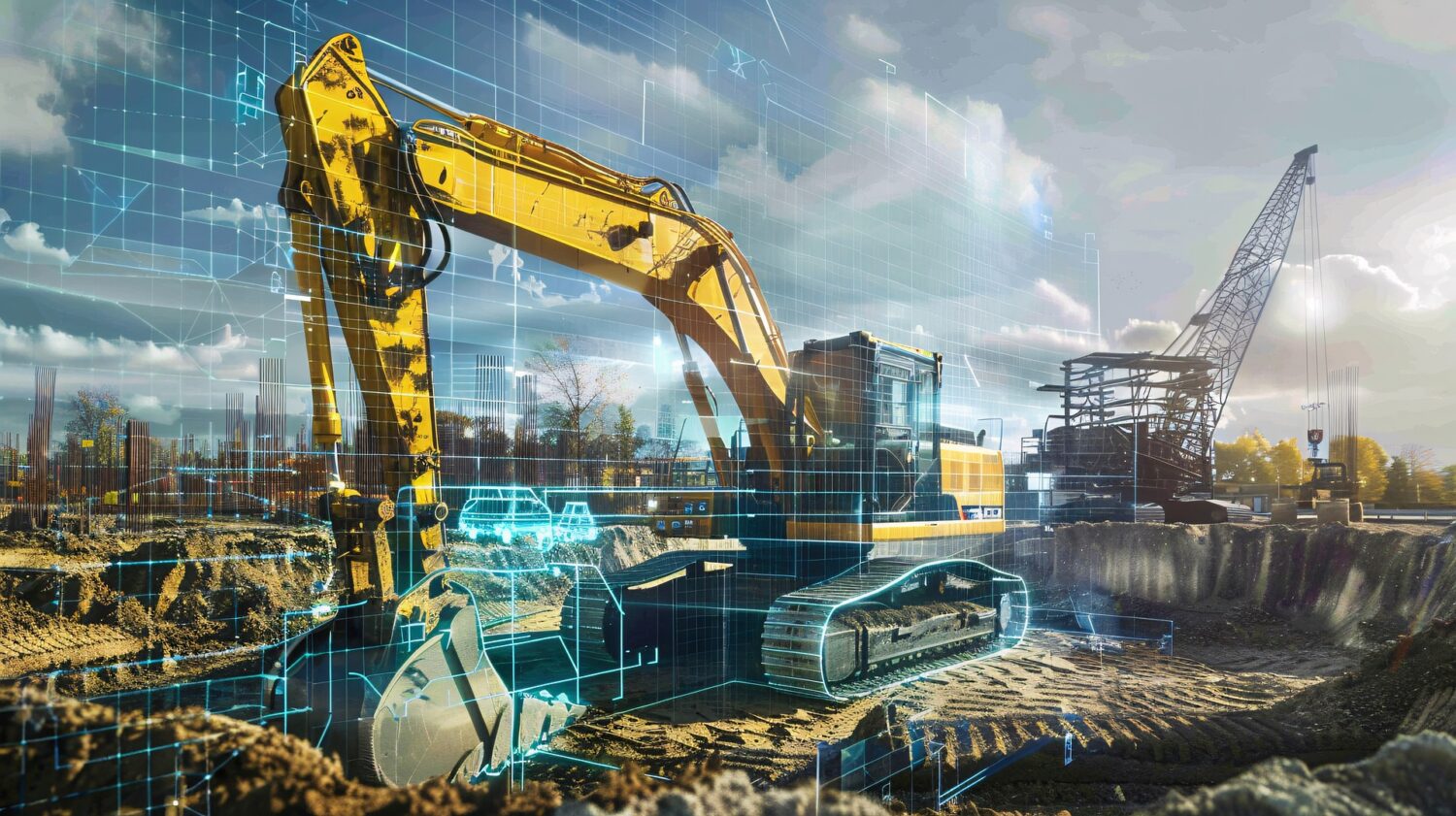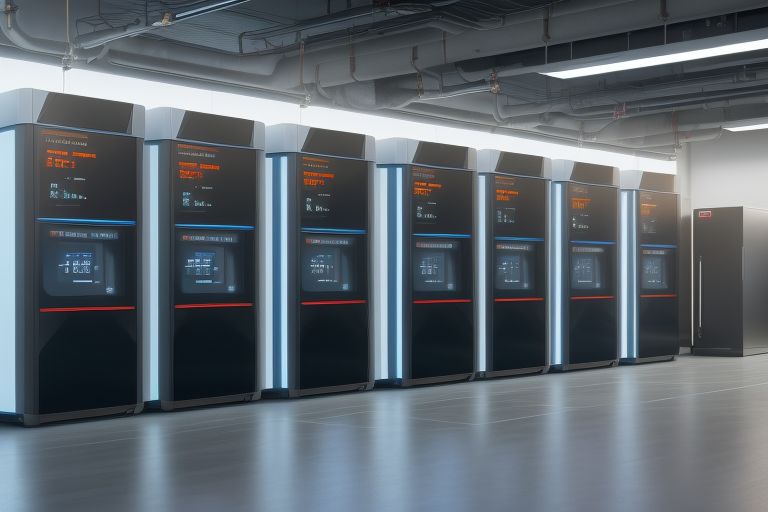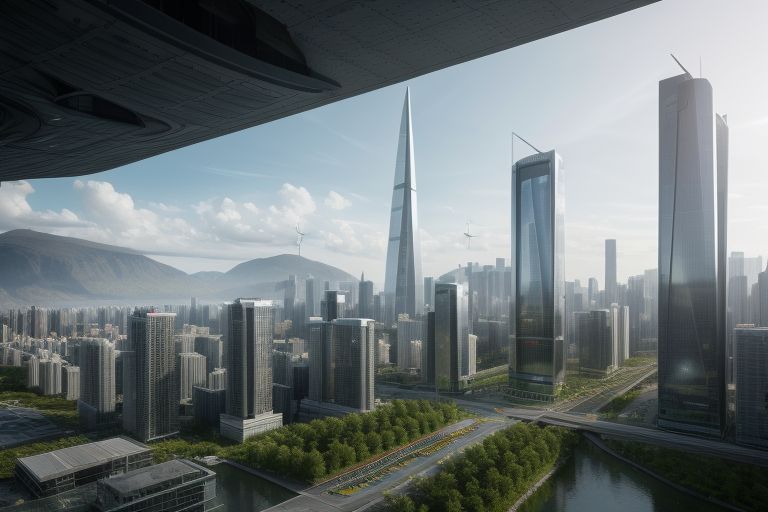- [email protected]
- +254 723 065019
- Mon - Sat 9:00 AM - 5:00 PM
- Login or Register
- Favorites
10.1 Emerging Technologies in Sustainable Construction
Lesson 10.1: Emerging Technologies in Sustainable Construction
Welcome to Lesson 10.1, where we will explore the exciting world of emerging technologies in sustainable construction. As the field of construction evolves, so do the technologies that drive it. This lesson will introduce you to some of the most innovative and promising technologies that are shaping the future of sustainable building practices.
In today’s rapidly changing construction landscape, emerging technologies play a crucial role in advancing sustainability. From cutting-edge materials to sophisticated energy systems, these technologies are transforming how we design, build, and operate buildings. They offer solutions to some of the most pressing environmental challenges, such as reducing carbon footprints, enhancing energy efficiency, and optimizing resource use.
In this lesson, we will cover:
- Overview of Emerging Technologies: An introduction to the latest technological advancements in sustainable construction and their potential impact on the industry.
- Innovative Building Materials: Exploring new materials that contribute to improved energy efficiency, durability, and environmental performance.
- Advanced Construction Techniques: Examining modern construction methods and systems that enhance sustainability and reduce environmental impact.
- Smart Building Technologies: Understanding how smart technologies are integrated into buildings to optimize performance, improve energy management, and enhance occupant comfort.
Objective:
By the end of this lesson, learners will:
- Gain Insight into Emerging Technologies: Develop a foundational understanding of the latest technological advancements in sustainable construction. This includes learning about innovative materials, construction methods, and smart technologies that are currently transforming the industry.
- Understand Contributions to Environmental Sustainability: Explore how these emerging technologies contribute to reducing environmental impact. This includes examining how they help in lowering carbon emissions, enhancing energy efficiency, and minimizing resource consumption.
- Evaluate Resource Efficiency: Learn how new technologies optimize the use of materials and resources. Understand their role in improving the efficiency of construction processes and the lifecycle performance of buildings.
- Assess Overall Building Performance: Analyze how these technologies improve building performance, including aspects such as energy management, indoor environmental quality, and operational efficiency.
This lesson will equip you with the knowledge to recognize and leverage emerging technologies in your future projects, helping you contribute to more sustainable and effective construction practices.

1. Introduction to Emerging Technologies
Emerging technologies are not only reshaping the way we build but are also setting new standards for what is possible in terms of sustainability and efficiency. As we navigate through this section, you’ll gain a comprehensive overview of the groundbreaking technologies that are transforming the construction industry. From advanced building materials to sophisticated energy systems, these innovations are designed to address the pressing challenges of environmental sustainability and resource efficiency.
Key topics we’ll cover include:
- Definition and Scope: Understanding what constitutes emerging technologies in the context of sustainable construction and their significance in shaping the future of the industry.
- Drivers of Innovation: Exploring the factors driving the development and adoption of these technologies, including environmental regulations, market demands, and technological advancements.
- Impact on Construction Practices: Examining how these technologies are altering traditional construction methods and contributing to more sustainable building practices.
Get ready to dive into the exciting world of innovation and discover how these emerging technologies are paving the way for a more sustainable future in construction.
Key Points:
a. Overview
Emerging technologies in construction represent a range of innovations designed to advance sustainability and efficiency in the built environment. These technologies include cutting-edge materials, advanced construction methods, and intelligent systems that significantly improve resource utilization, reduce environmental impact, and enhance the overall performance of buildings. By integrating these technologies, the construction industry can address key challenges such as energy consumption, waste management, and environmental degradation. Innovations such as smart building systems, green materials, and advanced energy technologies are leading the charge in transforming how we design, construct, and operate buildings.
b. Importance
Staying informed about emerging technologies is essential for professionals in the construction industry. As sustainability standards and regulations evolve, understanding and applying these technologies ensures that projects not only meet current requirements but also anticipate future trends. Embracing these innovations helps achieve higher levels of environmental performance, operational efficiency, and resource conservation. Additionally, incorporating advanced technologies can offer a competitive edge in the market, driving progress towards a more sustainable built environment and contributing to broader goals of reducing carbon footprints and promoting green building practices.
Understanding and integrating these technologies will be key to shaping the future of construction, ensuring that you remain at the forefront of industry advancements and make meaningful contributions to sustainable development.
Reflection Element:
Reflect on how emerging technologies can transform current construction practices and contribute to sustainability goals.

2. Advanced Building Materials
In this part of the lesson, we will delve into some of the most innovative materials that are revolutionizing the construction industry. These advanced materials are designed to enhance the sustainability, efficiency, and performance of buildings, offering significant benefits over traditional options.
As the quest for more sustainable and resilient construction methods continues, advanced building materials play a crucial role in meeting these demands. They bring a range of properties that can improve durability, reduce environmental impact, and enhance overall building performance. Whether it’s through extending the lifespan of structures, reducing maintenance needs, or offering superior thermal insulation, these materials represent the forefront of innovation in construction.
Key topics we’ll cover include:
- Self-Healing Concrete: Discover how this innovative material, embedded with bacteria that produce limestone, can autonomously heal cracks and extend the lifespan of concrete structures.
- Bio-Based Materials: Explore materials derived from renewable biological sources, such as bamboo, mycelium, and hempcrete, and understand their benefits in terms of sustainability and thermal performance.
- High-Performance Insulation: Learn about advanced insulation materials like aerogel and phase-change materials that provide exceptional thermal performance, contributing to energy efficiency and improved indoor comfort.
By the end of this section, you will have a deeper understanding of how these advanced materials contribute to sustainable construction practices. You’ll be equipped to evaluate their potential applications and benefits, paving the way for more innovative and environmentally responsible building solutions.
Key Points:
a. Self-Healing Concrete
Self-healing concrete represents a groundbreaking advancement in construction materials, designed to address one of the most common issues with traditional concrete: cracking. This innovative material incorporates specific bacteria, often encapsulated in microcapsules or other delivery mechanisms, that activate and produce limestone when exposed to moisture. The limestone fills and heals minor cracks that develop over time, effectively restoring the concrete’s structural integrity without the need for human intervention or extensive repair work.
Benefits:
-
- Extended Lifespan: Self-healing concrete significantly extends the lifespan of structures by autonomously repairing cracks. This capability reduces the frequency of repairs and replacements, thereby enhancing the longevity and durability of the concrete. Structures made with this material can maintain their strength and functionality for longer periods, making it a cost-effective choice in the long run.
- Reduced Maintenance Costs: The self-repairing nature of this concrete translates into lower maintenance expenses. Since minor cracks can be healed automatically, there is less need for manual repair work or major refurbishments. This reduction in maintenance requirements leads to operational cost savings and minimizes disruptions associated with traditional repair processes.
- Improved Durability: The ability of self-healing concrete to autonomously address cracks improves its overall durability. By continuously addressing minor structural damage, the material enhances the performance of concrete structures, making them more resilient to environmental stresses such as weather conditions, physical loads, and chemical exposure.
Self-healing concrete is a prime example of how advanced materials are transforming the construction industry, offering significant improvements in both performance and sustainability. Its application not only contributes to the durability of structures but also supports more efficient and cost-effective building practices.
b. Bio-Based Materials
Bio-based materials are innovative construction materials derived from renewable biological sources. Examples include bamboo, mycelium (fungal networks), and hempcrete (a hemp-based concrete alternative). These materials are designed to provide sustainable, eco-friendly alternatives to conventional building materials by leveraging natural processes and renewable resources.
Benefits:
-
- Lower Carbon Footprint: Bio-based materials significantly reduce the carbon footprint associated with construction. By using renewable resources, these materials help lower greenhouse gas emissions related to material production and processing. Their production typically involves less energy and fewer emissions compared to traditional materials, contributing to overall environmental sustainability.
- Reduced Reliance on Non-Renewable Resources: Utilizing bio-based materials helps decrease dependence on finite, non-renewable resources. Materials such as bamboo and hemp are rapidly renewable, meaning they can be grown and harvested in a short time compared to the long geological periods required for non-renewable resources. This shift towards renewable materials promotes a more sustainable approach to construction and reduces environmental impact.
- Improved Thermal Insulation: Many bio-based materials, such as hempcrete and mycelium, offer excellent thermal insulation properties. These materials contribute to enhanced energy efficiency in buildings by improving insulation, which helps maintain stable indoor temperatures and reduces heating and cooling costs. This not only lowers energy consumption but also enhances the overall comfort of the indoor environment.
Bio-based materials represent a significant advancement in sustainable construction, offering both environmental and performance benefits. Their integration into building practices supports a move towards more sustainable, energy-efficient, and eco-friendly construction solutions.
c. High-Performance Insulation
High-performance insulation materials, such as aerogel and phase-change materials (PCMs), represent significant advancements in building insulation technology. These materials surpass traditional insulation options in terms of thermal efficiency, offering enhanced performance that contributes to overall energy savings and improved indoor comfort.
-
- Aerogel: Known for its incredibly low thermal conductivity, aerogel is one of the most effective insulating materials available. Its lightweight, porous structure minimizes heat transfer, making it an excellent choice for situations where space is limited but high thermal performance is required.
- Phase-Change Materials (PCMs): PCMs absorb and release heat as they change phases between solid and liquid states. This property allows them to regulate indoor temperatures by storing excess heat and releasing it when temperatures drop, effectively smoothing out temperature fluctuations.
Benefits:
-
- Enhanced Energy Efficiency: High-performance insulation materials significantly improve the thermal efficiency of buildings. By reducing the amount of heat that escapes during colder months and preventing excessive heat gain during warmer months, these materials help lower overall energy consumption for heating and cooling. This leads to more efficient building operations and supports environmental sustainability.
- Reduced Heating and Cooling Costs: By minimizing heat loss and gain, high-performance insulation directly impacts energy bills. The improved insulation effectiveness reduces the demand on heating and cooling systems, resulting in lower energy costs and better cost-effectiveness for building owners and occupants.
- Improved Indoor Comfort: Better insulation contributes to more consistent and comfortable indoor temperatures. By maintaining a stable indoor climate and reducing temperature fluctuations, high-performance insulation enhances the overall living or working environment. This leads to increased comfort and satisfaction for building occupants.
Understanding and applying high-performance insulation materials in your projects will equip you with the tools to create more sustainable, energy-efficient buildings. Their advanced properties support modern construction practices aimed at improving environmental performance and occupant comfort.
Reflection Element:
Reflect on the benefits of self-healing concrete and bio-based materials in terms of sustainability and application. Think of their potential impacts on construction practices.

3. Building Information Modeling (BIM) and Digital Twins
Building Information Modeling (BIM) and Digital Twins represent groundbreaking advancements in the construction and management of buildings. These technologies are redefining how we approach the entire lifecycle of a building, from its initial design and construction to its ongoing operation and maintenance.
- Building Information Modeling (BIM) provides a detailed digital representation of a building’s physical and functional characteristics. It integrates architectural, structural, and operational data into a single, comprehensive model, allowing for improved accuracy in design, enhanced collaboration among project stakeholders, and streamlined management of construction processes.
- Digital Twins take this a step further by creating virtual replicas of physical buildings that simulate real-time performance and conditions. This technology allows for continuous monitoring and analysis, enabling predictive maintenance, real-time adjustments, and optimization of building systems to improve energy efficiency and operational performance.
In this section, we will delve into how BIM and Digital Twins are transforming the construction industry. We’ll explore their capabilities, benefits, and the significant impact they have on building design, management, and sustainability. Understanding these technologies will equip you with valuable insights into the future of construction and how digital innovations are shaping the built environment.
Key Points:
a. Building Information Modeling (BIM):
Building Information Modeling (BIM) is a transformative digital tool that captures both the physical and functional characteristics of a building. It creates a comprehensive digital representation, or model, that integrates multiple data layers including architectural designs, structural components, and building systems. This model is utilized throughout the planning, design, and construction phases of a project, offering a holistic view of the building’s attributes and performance.
Benefits:
1. Improved Accuracy in Design:
BIM significantly enhances design precision by enabling detailed visualization and simulation of the building before construction begins. Through its 3D models and advanced simulations, BIM allows stakeholders to foresee and address potential issues early in the design phase. This proactive approach minimizes costly errors and modifications during construction, leading to a more accurate and reliable build.
2. Enhanced Collaboration Among Stakeholders:
One of BIM’s key strengths is its ability to foster collaboration. The model serves as a shared platform where architects, engineers, contractors, and other stakeholders can access and contribute to the project. This integrated approach improves communication and coordination among all parties involved, ensuring that everyone is aligned with the project’s goals and requirements. Enhanced collaboration leads to more effective project management and execution.
3. Efficient Management of Construction Processes:
BIM streamlines construction planning and coordination by consolidating various aspects of the building into a single digital framework. This integration facilitates more efficient scheduling, resource management, and quality control. With BIM, project teams can better manage construction workflows, optimize resource allocation, and maintain high standards of quality throughout the building process. As a result, projects are more likely to be completed on time and within budget.
Building Information Modeling (BIM) revolutionizes how buildings are designed, constructed, and managed by providing a detailed, collaborative, and efficient approach to project development. Understanding and leveraging BIM can lead to more successful and sustainable construction outcomes.
b. Digital Twins:
Digital Twins are sophisticated virtual replicas of physical buildings that simulate real-time performance and conditions. These dynamic models are continuously updated with data from sensors and other monitoring tools, reflecting the current state of the building and its systems. By providing a comprehensive and current view of building operations, Digital Twins offer valuable insights throughout the building’s lifecycle.
Benefits:
1. Enables Predictive Maintenance:
Digital Twins facilitate predictive maintenance by analyzing real-time data to detect potential issues before they escalate. This proactive approach allows for timely interventions, helping to extend the lifespan of building systems and minimize the risk of unexpected failures. By addressing problems early, facilities can avoid costly repairs and ensure smoother operations.
2. Real-Time Monitoring:
Digital Twins offer continuous real-time monitoring of various building systems and conditions. This constant oversight allows building operators to track performance, identify inefficiencies, and make informed decisions based on live data. Real-time monitoring ensures that systems function optimally, and any deviations or issues can be addressed promptly.
3. Optimization of Building Systems for Energy Efficiency:
Digital Twins play a crucial role in optimizing energy use within buildings. By simulating and analyzing building performance, these models provide insights into how different systems interact and affect overall energy consumption. This capability enables operators to make adjustments that enhance energy conservation and improve the building’s sustainability. Digital Twins help in identifying opportunities for energy savings and implementing strategies that contribute to a greener, more efficient building.
In summary, Digital Twins represent a significant advancement in building management and sustainability. By integrating real-time data with virtual models, they offer powerful tools for predictive maintenance, continuous monitoring, and energy optimization. Understanding how Digital Twins work can enhance your ability to manage and improve building performance effectively, contributing to smarter and more sustainable construction practices.
Reflection Element:
Reflect on how BIM and digital twins can improve project outcomes and sustainability. Think about how these technologies have been implemented in real-world projects.

4. Renewable Energy Integration
Renewable energy integration is a critical component in advancing sustainable construction practices and reducing the environmental impact of buildings. By incorporating renewable energy technologies, buildings can generate their own clean energy, minimize their reliance on traditional power sources, and contribute to a more resilient and sustainable energy infrastructure. This section will explore key strategies and technologies for integrating renewable energy into building designs, focusing on Building-Integrated Photovoltaics (BIPV) and Energy Storage Systems.
- Building-Integrated Photovoltaics (BIPV): This innovative approach involves embedding solar panels directly into building materials such as windows, facades, and roofs. BIPV systems not only generate renewable energy but also enhance the aesthetic quality of the building by seamlessly integrating with its design.
- Energy Storage Systems: Advanced batteries and other energy storage solutions play a crucial role in capturing and storing excess energy generated from renewable sources. These systems improve energy reliability, support grid stability, and optimize energy use within buildings by ensuring that stored energy can be used when needed.
Understanding how these renewable energy technologies can be integrated into building designs will equip you with the knowledge to create more energy-efficient and environmentally friendly structures.
Key Points:
a. Building-Integrated Photovoltaics (BIPV)
Building-Integrated Photovoltaics (BIPV) represent a cutting-edge approach to solar energy integration, where photovoltaic (PV) panels are seamlessly incorporated into building materials such as windows, facades, and roofs. Unlike traditional solar panels that are installed on top of existing structures, BIPV systems are embedded within the building envelope, serving a dual purpose of energy generation and architectural enhancement.
Benefits:
1. Generates Renewable Energy:
BIPV systems convert sunlight into electricity directly within the building’s structure. This on-site generation of clean, renewable energy reduces the building’s reliance on conventional grid power, helping to lower energy costs and contribute to a greener energy landscape.
2. Reduces Reliance on Grid Power:
By producing its own electricity, a building equipped with BIPV systems can decrease its dependence on external energy sources. This not only cuts energy bills but also supports the broader goal of reducing the strain on the grid and promoting sustainable energy practices.
3. Maintains Aesthetic Quality:
One of the key advantages of BIPV is its ability to integrate seamlessly with building materials. BIPV solutions are designed to complement the building’s architectural aesthetics, blending in with facades, windows, and roofs. This integration allows for a visually appealing design while still achieving energy generation, ensuring that the functionality of the energy system does not compromise the building’s appearance.
Incorporating BIPV into building designs provides a forward-thinking solution for renewable energy integration, balancing energy efficiency with architectural aesthetics and contributing to the overall sustainability of modern construction.
b. Energy Storage Systems
Energy Storage Systems (ESS) are advanced technologies designed to store excess energy generated from renewable sources, such as solar panels or wind turbines. These systems capture surplus energy during periods of high production and release it when production is low or energy demand is high, ensuring a steady and reliable energy supply.
Benefits:
1. Enhances Energy Reliability:
ESS provides a consistent supply of electricity by storing excess energy generated during peak production times. This ensures that energy is available even when renewable sources are not actively generating power, reducing the risk of power outages and improving overall energy reliability for buildings.
2. Supports Grid Stability:
By storing and dispatching energy, ESS can help stabilize the electrical grid. During peak demand periods, stored energy can be fed back into the grid, balancing supply and demand. This reduces strain on grid infrastructure and supports grid stability, contributing to a more resilient energy system.
3. Optimizes Energy Use Within Buildings:
Energy storage systems enable efficient management of a building’s energy use by storing excess on-site generated renewable energy. This helps maximize the utilization of renewable energy, minimizes reliance on external power sources, and enhances overall energy efficiency within the building.
Incorporating Energy Storage Systems alongside Building-Integrated Photovoltaics (BIPV) ensures that buildings can fully leverage renewable energy technologies, leading to improved sustainability, energy independence, and resilience. Understanding these systems is essential for developing advanced, energy-efficient buildings that contribute positively to the environment and energy infrastructure.
Reflection Element:
Reflect on the impact of BIPV and energy storage systems on building energy efficiency and sustainability. Think about how these technologies contribute to reducing a building’s carbon footprint.

5. Smart Building Technologies
In the evolving landscape of sustainable construction, smart building technologies are playing a pivotal role in enhancing the efficiency and functionality of modern buildings. These technologies leverage advanced digital solutions to optimize building performance, improve energy management, and enhance occupant comfort. By integrating systems that monitor, analyze, and control various building functions, smart technologies are transforming how buildings operate and interact with their environments.
Key Points:
a. Internet of Things (IoT) for Buildings
The Internet of Things (IoT) refers to a network of interconnected sensors and devices embedded throughout a building. These IoT components continuously monitor and control various building systems, including lighting, heating, ventilation, air conditioning (HVAC), and security systems. By collecting and transmitting real-time data, IoT technology provides a comprehensive view of building operations, allowing for seamless management and optimization of resources.
Benefits:
1. Optimizes Building Operations:
IoT sensors offer real-time insights into how different systems within a building are performing. This data enables automated adjustments based on current conditions and occupancy levels, leading to more efficient management of resources. For example, IoT can automatically dim lights in unoccupied areas or adjust HVAC settings based on the number of people present, thereby enhancing operational efficiency.
2. Improves Energy Efficiency:
By analyzing energy consumption patterns and dynamically controlling building systems, IoT helps in minimizing energy waste. Sensors can detect when rooms are unoccupied and adjust lighting and temperature settings accordingly. For instance, IoT systems can lower HVAC usage during cooler months or reduce lighting intensity during daylight hours, leading to substantial energy savings and reduced utility costs.
3. Enhances Occupant Comfort:
IoT technology enables automated control of environmental conditions to ensure optimal comfort for building occupants. Systems can adjust lighting, temperature, and air quality based on real-time data and individual preferences. This capability not only creates a more pleasant living or working environment but also ensures that comfort levels are consistently maintained without manual intervention.
The integration of IoT in building management offers a transformative approach to enhancing efficiency, sustainability, and occupant satisfaction. By leveraging real-time data and automated controls, buildings become smarter, more responsive, and better suited to modern needs.
b. Artificial Intelligence (AI) in Building Management
Artificial Intelligence (AI) utilizes sophisticated algorithms and machine learning techniques to analyze and interpret large volumes of data from building systems. By processing this data, AI tools can optimize energy usage, predict maintenance needs, and enhance overall building performance. AI systems continuously learn from historical data and real-time inputs to make data-driven decisions and recommendations, leading to more efficient building management.
Benefits:
1. Increases Operational Efficiency:
AI algorithms streamline building management by automating complex tasks and predicting system performance. For instance, AI can forecast energy needs based on occupancy patterns and external weather conditions, allowing for optimized operation of HVAC and lighting systems. This automation and optimization lead to more efficient operations and better resource management.
2. Reduces Energy Costs:
AI employs predictive analytics to analyze energy consumption patterns and make real-time adjustments. By identifying trends and inefficiencies, AI can suggest modifications to reduce energy usage and lower utility costs. For example, AI might adjust temperature settings or lighting levels based on predicted occupancy, contributing to substantial energy savings.
3. Extends the Lifespan of Building Systems:
AI enhances predictive maintenance by identifying potential issues before they escalate into significant problems. By analyzing data from various building systems, AI can forecast when equipment might fail or require maintenance. This proactive approach helps to extend the lifespan of critical building systems and reduces the risk of unexpected breakdowns.
Understanding how AI integrates into building management offers valuable insights into its role in enhancing operational efficiency, reducing costs, and improving system longevity. The use of AI in building management transforms traditional practices, providing a more intelligent and responsive approach to maintaining and optimizing building performance.
Reflection Element:
Reflect on how IoT and AI can enhance the management and operation of sustainable buildings. Think about potential challenges and benefits of implementing these technologies.
In Lesson 10.1, we’ve explored some of the most exciting emerging technologies shaping the future of sustainable construction. From advanced building materials like self-healing concrete and bio-based materials to the transformative impacts of Building Information Modeling (BIM), Digital Twins, and smart building technologies such as IoT and AI, these innovations are driving significant advancements in building efficiency, durability, and environmental stewardship.
As you move forward, consider how these technologies can be applied to your projects to enhance sustainability and operational performance. Understanding and leveraging these tools will not only prepare you for future industry demands but also contribute to the creation of more resilient and eco-friendly buildings.
In Lesson 10.2, we will delve into The Future of Green Building Practices. This section will provide you with a forward-looking perspective on how sustainable building practices are evolving and what trends and innovations are expected to shape the industry in the years to come. We’ll explore emerging strategies, regulations, and technologies that promise to redefine green building standards and push the boundaries of sustainability.
Get ready to expand your knowledge and discover how the future of green building is being shaped by new practices and innovations.

